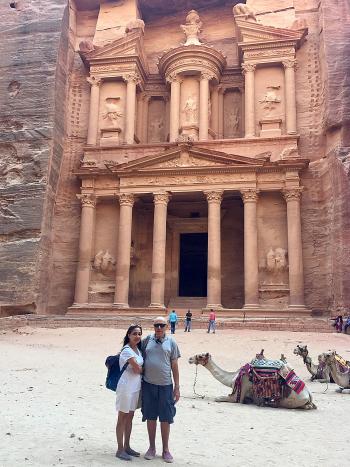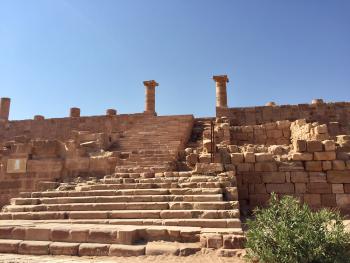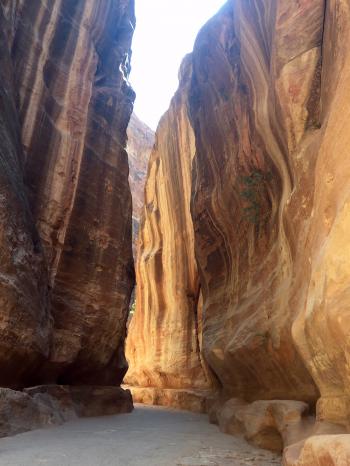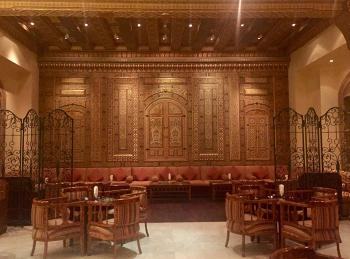Enjoying Petra’s awesome sights, by day and by night
This article appears on page 34 of the January 2018 issue.
Some 10 years ago, when completing a tour of Turkey’s Ephesus, our archaeological-student guide said, “Now that you have seen the finest restoration of an ancient city, I suggest you go to my second favorite, Petra in Jordan.”
My wife, Maria, and I put that suggestion on our travel “B list,” and this past summer, after attending a destination wedding in southern Spain, we headed to this awesome UNESCO World Heritage Site.
A bit of background
Constructed in the third century BC by the nomadic Nabataean tribe, this ancient desert city included palaces, temples and tombs carved from the sandstone cliffs. From Petra, the Nabataeans dominated the caravan trade routes, carrying spices, silk and slaves from Damascus to Arabia, with links to China, India, Greece and Rome.
Masters of iron production, copper refining and stone carving, they built a spectacular city financed by taxes and “protection” money collected from passing caravans. Their skills in hydraulic engineering enabled them to provide sufficient water for the desert city through a series of dams, conduits and cisterns.
Often called Jordan’s “Lost City,” Petra was unknown to the West until 1812, when it was “rediscovered” by Swiss explorer Johann Burckhardt. Tourist visits spiked after the site was featured in scenes of the 1989 film “Indiana Jones and the Last Crusade.”
Entry into the past
The dramatic approach to the 100-square-mile Petra Valley is through a 1½-mile descending pathway that includes a ¾-mile sheer, narrow gorge known as the Siq. The vertical walls of the Siq are the result of the mountain having been split by violent tectonic forces.
Day passes to the site cost JOD50 ($71) and include a short donkey or horse ride to the pathway. To encourage visitors to remain overnight in the adjacent city of Wadi Musa — an excellent idea — 2-day passes cost just JOD55.
Excellent previsit Petra information is available from the Jordan Tourism Board (McLean, VA; 703/246-7404, www.visitjordan.com).
The Siq opens into a huge plaza, where visitors are overwhelmed by Petra’s most breathtaking sight: the facade of The Treasury. Its rose-colored exterior, some 130 feet high, is decorated with Greek-style pillars, figures, friezes and other stone carvings that are masterpieces of giant masonry work.
Actually a tomb, The Treasury gets its name from the mistaken belief that treasure was hidden inside an urn carved into the upper level of the facade.
We followed the path from The Treasury along the broad Street of Facades, viewing the intricate wall carvings of some 40 giant tombs sculpted into the canyon’s cliffs. Adjacent, the High Place of Sacrifice, a hilltop altar used for important religious ceremonies, required a 45-minute climb.
Under the High Place of Sacrifice is a large plaza and Petra’s second-most dramatic sight: the 5,000-seat Roman-style amphitheater. Seven stairways ascend the huge auditorium. Almost enclosing the theater on three sides are rose-colored wall carvings of towers cut from the mountain rock.
The Royal Tombs, the most sophisticated burial places in Petra, are located across from the theater. The four adjacent facades, cut into the steep cliffs, display some of the site’s finest carvings.
The Urn Tomb contains a deep courtyard with colonnades on two sides, the Silk Tomb facade features swirls of colored rock, and the Palace Tomb is well worth the 30-minute climb to view it up close.
Continuing along the Street of Tombs, we passed the front of the elevated Great Temple as well as the Temple of the Winged Lions and the stately Dushares Temple, the latter being one of the few freestanding structures in Petra.
The final push
Reaching the end of the valley, we started along the winding path to the third of Petra’s most dramatic sights, Ad Deir, or The Monastery. The path, featuring a more-than-800-step staircase, was an exhausting, one-hour-plus climbing challenge. It’s best to take this in the early morning or late afternoon, especially during the warmer summer months, but horse and donkey rides to the top do offer an alternative (though riding a donkey up 800 steps would be a jarring experience, to say the least).
Built, perhaps, as a temple, The Monastery is entered through a doorway that rises several stories high. The benches and altar that line the rear wall were used for religious ceremonies and meetings, and crosses on the rear wall were likely carved when the hall was used as a Christian chapel during Byzantine times.
A cave located opposite The Monastery houses a small café offering refreshments, providing a shady spot from which to admire the site.
Note that no matter what time of day you tour Petra in the warmer months, you should take a wide-brimmed hat and sufficient sunscreen and water, though bottles of water are available at a few kiosks in the valley.
Planning a visit
There are a number of options for visiting Petra. Day trips are available from both Amman, Jordan’s capital, and Eilat, Israel. While the 236-kilometer trip from Amman can be completed in just over three hours, the shorter-distance ride (136 km) from Eilat can often take four and more hours, depending on the delays at the Jordanian border. The result can be a very long day in which your travel time is longer than your time at Petra.
Neither trip allows for an early-morning or late-afternoon visit to the valley, the best times from a crowd and weather point of view.
Day-trippers also miss the fascinating “Petra By Night” experience (JOD17), which allows visitors to descend into the site an hour after sundown guided by the light of 1,000 candles lining the path into the valley.
We entered the site at The Treasury plaza, which glowed with the light of some 200 candles, The Treasury, itself, illuminated to provide a dramatic backdrop.
Seated on the ground (take a towel or blanket), we were served sweet tea while listening to a short history of the site and its excavation, followed by a brief concert of traditional wind and string instruments and Arabic chants.
We then retraced our steps back up to the valley entrance, completing a very special 2-hour experience.
In Petra, consider staying, as my wife and I did, at the lovely 5-star Mövenpick Resort Petra (phone +962 3215 71 11, www.movenpick.com/petra), just 50 yards from the historic site’s entrance. (This location was especially appreciated when leaving to visit the site in the early morning and on our return from the night walk.)
The hotel and our driver from Amman were recommended to us by a colleague/professor who has spent a great deal of time in Jordan, and his recommendations greatly enhanced our trip.
The 183-room resort featured a variety of accommodations and amenities, including a large outdoor pool and a small exercise room. Its international breakfast buffet was outstanding, and the seasonal Al Ghadee rooftop bar was a lovely informal spot for a drink and sunset watching.
We booked directly through the hotel’s website and paid JOD160 ($226) for a junior suite, including buffet breakfast.
We lunched at Petra Zaman, on Tourism Street near our hotel. Small, with friendly staff, the restaurant features Middle Eastern and Mediterranean dishes. We had a good lunch for two for JOD35.
A few final notes
Our driver, Mosa Kanan (mosa kanan@yahoo.com), spoke English well, and he was quite flexible in adjusting to our schedule. He also had many good suggestions for our trip. He was even recommended in a Lonely Planet write-up on Amman, which is where he picked us up for our round-trip journey to Petra. (We paid Mosa a total of $350, which included two half days’ traveling around Amman.)
Taxis from Amman charge JOD60-JOD80 for a one-way trip to/from Petra, but that rate is negotiable. For local cab rides, make sure meters are being used or get an agreement on the total rate in advance.
Also be aware that hotels, major tourist sites and “international” restaurants are supposed to offer the choice of paying in local or your home currency when using a foreign-based credit card; unfortunately, they often neglect to do so. Even if you have a card that waives international service charges, paying in US dollars means you will be charged the local conversion rate, which can result in your paying 4%-6% more than if your home bank made the conversion.
If you are traveling from Amman and plan to overnight in Petra, you can make a stop on your way to or from Amman at Madaba, the “city of mosaics.” The chief attraction there is the Greek Orthodox Church of St. George and the remains of its (originally) two-million-piece mosaic map of Jerusalem and other holy sites. Some 35 by 15 feet in size, the mosaic depicted regional hills, valleys, villages and towns from as far away as the Nile Delta.
A second possible stop between Petra and Amman would be the walled Crusader city of Karak, dominated by Karak Castle, the largest in Jordan. The city also features a number of restored 19th-century Ottoman buildings.
An overnight Petra visit, preferably in the better weather of spring or fall, should well be among your personal 25 trips to make in a lifetime.




